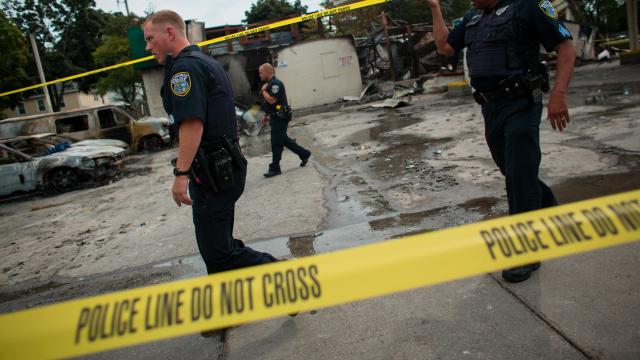On Monday, the FBI released its latest “Crime in the United States” figures, a closely watched (albeit historically problematic) data set that relies on the voluntary reporting of thousands of law enforcement agencies across the country.
Throughout the week, many Americans are likely to hear about how the violent crime rate has “fallen for the second year” in a row. If he hasn’t already, Trump will probably post a tweet soon taking credit for the statistical decline. TV pundits who favour the administration’s tough immigration stance will probably tout the figures as proof that its policies are working.
What will largely go unsaid is that the FBI’s figures have long suffered from inaccuracies stemming not only from its flawed collection process but also its internal methodology. Here’s one hypothetical The Conversation offered last year to demonstrate how data on “serious” offences can be easily distorted:
Take this example. You live in a nice neighbourhood with a Kmart on the edge of it. “Serious” crime includes all the shoplifting from the Kmart; let’s say 150 incidents in a year. It also includes all the murders and rapes; call it 20 incidents in a year. The Kmart closes. All of a sudden, your crime rate has gone from 170 to 20: an 88 per cent decrease in crime.
However, the FBI also offers data that focuses entirely on “violent crime.” This year’s figures show is that in 2018, there were an estimated 1,206,836 violent crimes — a 3.9 per cent drop from the previous year. (Violent crimes are limited to murder and non-negligent manslaughter, rape, robbery and aggravated assault.)
Most violent crimes go unreported and, thus, are not included in the FBI’s data. The U.S. Bureau of Justice Statistics (BJS), which conducts surveys of crime victims ages 12 and older for the U.S. Justice Department, found that as of 2017 only 45 per cent of the violent crimes tracked by the agency were reported to police. That same year, only one-third, or 36 per cent, of property crimes got reported. The FBI’s latest figures claim property crime is down 6.3 per cent. (You can read about BJS’s methodology here.)
The Wall Street Journal reported on some troubling errors found in last year’s “Crime in the United States” related to the “crude estimates” FBI uses to compensate for missing data:
In its latest report, the FBI didn’t adjust the counts of violent crime for 11 states at all. But it inflated Indiana’s numbers by 9.9 per cent, West Virginia’s by 13 per cent and Mississippi’s by 68 per cent, raising that state’s count to an estimated 8,526, up from a reported 5,084.
Homicide figures also had to be adjusted due to missing data, though that apparently didn’t happen for every U.S. state. Sometimes, the estimates used by FBI to fill in the gaps “stray substantially from reported numbers,” according to the Journal:
The numbers for 28 states were not adjusted, but Mississippi’s count, the worst of the bunch, was increased by 56 per cent, to an estimated 245 murders from a reported 157.
For an idea of how often the FBI was forced to rely on estimations in its new report, nearly 2,000 — or 10.3 per cent — of the country’s 18,586 law enforcement agencies did not share data with the bureau.
The FBI figures released today also show that while violent crime is purportedly down, the number of rapes reported has jumped by 2.7 per cent. But just as it would be ill-advised to assume that “violent crime has dropped” based on the FBI’s data, it’s also tricky to suggest the rate of rape is going up.
As with many other types of crimes, the figures are entirely based on the number of victims who come forward, explaining why FBI’s homicide figures are generally considered the most reliable. The U.S. Rape, Abuse & Incest National Network estimates that roughly three out of four sexual assaults go unreported.
However, BJS’s latest report does support the conclusion that there’s been an increase in rape and sexual assault since 2017: “[T]he rate of rape or sexual-assault victimization increased from 1.4 victimizations per 1,000 persons age 12 or older in 2017 to 2.7 in 2018,” it says. This is a significant spike from recent years. (Between 2014 and 2017, the highest figure reported, in 2015, was 1.6 per 1,000 persons age 12 or older.)
The FBI has only been including statistics on male rape victims since 2013. It previously reported only what it called “forcible rape,” i.e., “carnal knowledge of a female forcibly and against her will.” Its new definition includes “penetration, no matter how slight, of the vagina or anus with any body part or object, or oral penetration by a sex organ of another person, without the consent of the victim.” The statistics notably exclude charges of incest and what the law considers “statutory rape,” which may significantly skew the totals.
According to the FBI, an estimated 10.3 million arrests were made in 2018, including for traffic violations.
If you or anyone you know is a victim of sexual assault, contact 1800RESPECT, Australia’s national sexual assault, domestic violence and family violence counselling hotline.
